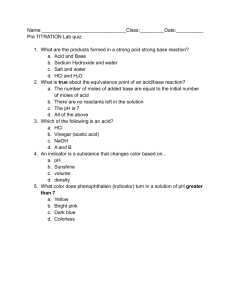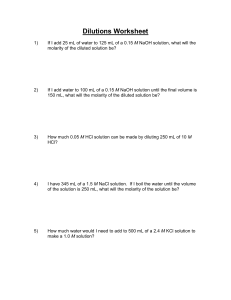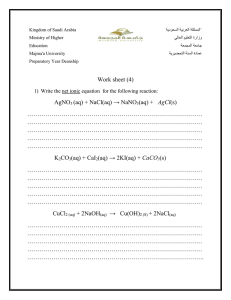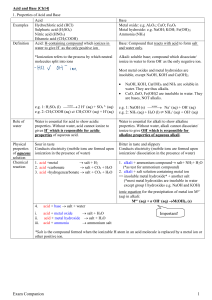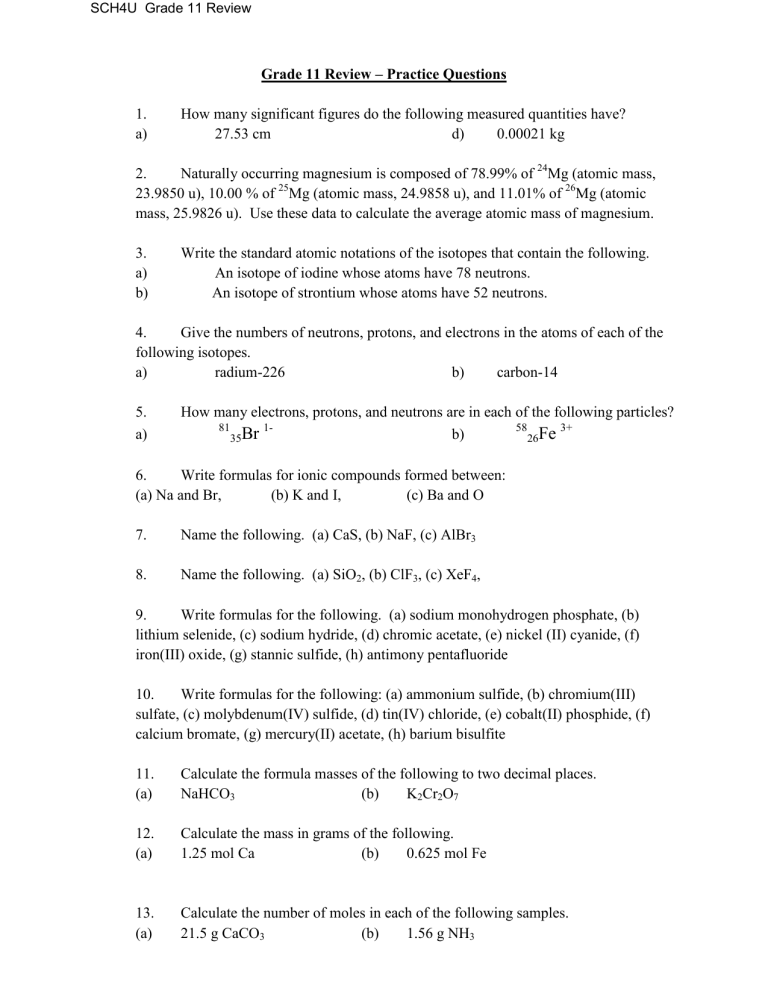
SCH4U Grade 11 Review Grade 11 Review – Practice Questions 1. a) How many significant figures do the following measured quantities have? 27.53 cm d) 0.00021 kg 2. Naturally occurring magnesium is composed of 78.99% of 24Mg (atomic mass, 23.9850 u), 10.00 % of 25Mg (atomic mass, 24.9858 u), and 11.01% of 26Mg (atomic mass, 25.9826 u). Use these data to calculate the average atomic mass of magnesium. 3. a) b) Write the standard atomic notations of the isotopes that contain the following. An isotope of iodine whose atoms have 78 neutrons. An isotope of strontium whose atoms have 52 neutrons. 4. Give the numbers of neutrons, protons, and electrons in the atoms of each of the following isotopes. a) radium-226 b) carbon-14 5. a) How many electrons, protons, and neutrons are in each of the following particles? 81 158 3+ b) 35Br 26Fe 6. Write formulas for ionic compounds formed between: (a) Na and Br, (b) K and I, (c) Ba and O 7. Name the following. (a) CaS, (b) NaF, (c) AlBr3 8. Name the following. (a) SiO2, (b) ClF3, (c) XeF4, 9. Write formulas for the following. (a) sodium monohydrogen phosphate, (b) lithium selenide, (c) sodium hydride, (d) chromic acetate, (e) nickel (II) cyanide, (f) iron(III) oxide, (g) stannic sulfide, (h) antimony pentafluoride 10. Write formulas for the following: (a) ammonium sulfide, (b) chromium(III) sulfate, (c) molybdenum(IV) sulfide, (d) tin(IV) chloride, (e) cobalt(II) phosphide, (f) calcium bromate, (g) mercury(II) acetate, (h) barium bisulfite 11. (a) Calculate the formula masses of the following to two decimal places. NaHCO3 (b) K2Cr2O7 12. (a) Calculate the mass in grams of the following. 1.25 mol Ca (b) 0.625 mol Fe 13. (a) Calculate the number of moles in each of the following samples. 21.5 g CaCO3 (b) 1.56 g NH3 SCH4U Grade 11 Review 14. If a sample of sulfuric acid contains 12.64 g of S, how many grams of O and of H are also present? 15. Calculate the percentage of nitrogen in ammonia, NH3, and urea, CO(NH2)2. (These are two major nitrogen fertilizers used in agriculture worldwide.) 16. One compound of mercury with a formula mass of 519 contains 77.26% Hg, 9.25% C, and 1.17% H (with the balance being O). Calculate the empirical and molecular formulas, arranging the symbols in the order HgCHO. 17. (a) (b) Balance the following equations. Ca(OH)2 + HCl → CaCl2 + H2O AgNO3 + CaCl2 → Ca(NO3)2 + AgCl 18. Chlorine is used by textile manufacturers to bleach cloth. Excess chlorine is destroyed by its reaction with sodium thiosulfate, Na2S2O3, as follows. Na2S2O3(aq) + 4 Cl2(g) + 5 H2O(l) → 2 NaHSO4(aq) + 8 HCl(aq) (a) How many moles of Na2S2O3 are needed to react with 0.12 mol of Cl2? (b) How many moles of HCl can form from 0.12 mol of Cl2? 19. In dilute nitric acid, HNO3, copper metal dissolves according to the following equation. 3 Cu(s) + 8 HNO3 (aq) → 3 Cu(NO3)2 (aq) + 2 NO(g) + 4 H2O(l) How many moles of HNO3 are needed to dissolve 11.45 g of Cu according to this equation? 20. Zinc and sulfur react to form zinc sulfide according to the equation. Zn + S → ZnS In an experiment, 30.0 g of zinc and 36.0 g of sulfur are mixed. (a) Which chemical is the limiting reactant? (b) How many grams of ZnS can form? (c) How many grams of the excess reactant will be left over after the reaction? 21. Aluminum sulfate can be made be the following reaction. 2 AlCl3(aq) + 3 H2SO4(aq) → Al2(SO4)3 (aq) + 6 HCl(aq) It is quite soluble in water, so to isolate it the solution has to be evaporated to dryness. This drives off the volatile HCl, but the residual solid has to be heated to a little over 200oC to drive off all of the water. In one experiment, 25.00 g of AlCl3 was used. (a) How many grams of H2SO4 are needed? (b) There was eventually isolated 28.36 g of pure Al2(SO4)3. Calculate the percentage yield. 22. (a) Write ionic and net ionic equations for these reactions. (NH4)2CO3(aq) + MgCl2(aq) → 2 NH4Cl(aq) + MgCO3(s) SCH4U Grade 11 Review (b) CuCl2(aq) + 2NaOH(aq) → Cu(OH)2(s) + 2 NaCl(aq) 23. Use the solubility rules to decide which of the following compounds are insoluble in water. (a) AgCl (b) Cr2(SO4)3 (c) (NH4)2CO3 24. (a) (b) Calculate the molarity of a solution prepared by dissolving. 4.00 g of NaOH in 100.0 mL of solution. 16.0 g of CaCl2 in 250.0 mL of solution. 25. (a) Calculate the number of moles of each of the ions in the following solutions. 35.0 mL of 1.25 M KOH (b) 32.3 mL of 0.45 M CaCl2 26. Calculate the concentrations of each of the ions in 0.25 M Cr(NO3)2 27. If 25.0 mL of 0.56 M H2SO4 is diluted to a volume of 125 mL, what is the molarity of the resulting solution? 28. What is the molarity of an aqueous sulfuric acid solution if 12.88 mL is neutralized by 26.04 mL of 0.1024 M NaOH? The reaction is 2 NaOH(aq) + H2SO4 (aq) → KCl(aq) + H2O(l) 29. In a titration, 23.25 mL of 0.105 M NaOH was needed to react with 21.45 mL of HCl solution. What is the molarity of the acid? 30. Write Lewis symbols for the following atoms: (a) Si, (b) Sb, (c) Ba, (d) Al, (e) S 31. Write Lewis symbols for the following ions: (a) K+, (b) Al3+, (c) S2-, (d) Si4-, (e) Mg2+ 32. Draw Lewis structures for: (a) SiCl4, (b) PF3, (c) PH3, and (d) SCl2. 33. At STP how many molecules of H2 are in 22.4 L? 34. A steel cylinder with a volume of 25.0 L contains nitrogen under a pressure of 148 atm and a temperature of 25.0oC. How many moles of nitrogen does the cylinder contain?
